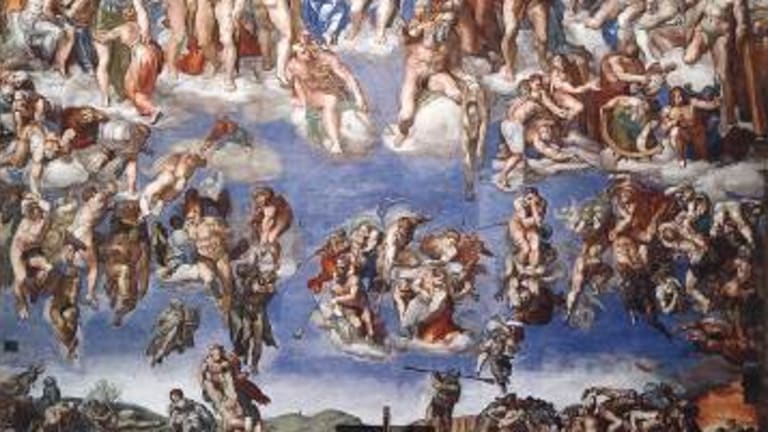The Vatican is the all-star team of tourism. You’ve got St. Peter’s, the Sistine Chapel, and those scary clown guards with axes. The place is a 20-minute walk from my hotel, but I was uncertain at first. Is it cool for a man, a decidedly non-Catholic man, to visit the Sistine Chapel?
I hit the Colosseum and some other must-sees first. Gladiators seemed pretty manly, though I was less sure of that after seeing tour guides there dressed in tunics, skirts, and spiky leather belts.
Eventually, the Hand of God reached out. The Sistine Chapel is one of those places I read about early in life and thought of as History (or, as Pete Sampras said after winning his third straight Wimbledon, “history, baby”). I can remember coming across the SC as a kid reading encyclopedias on hot summer afternoons (for some reason, I did this while lying upside down off the living-room couch). Isn’t that how you spent your vacation between fourth and fifth grade?
So the other morning fellow tennis scribbler Tom Tebbutt and I took the 13 euro plunge into the Musei Vaticani, which houses the Sistine Chapel—along with, we soon found out, many, many, many other rooms, paintings, murals, sculptures, and all manner of holy objects. And you must see them all. There is just one route through the museum, and it winds into and out of every last room in the joint. Who said the Vatican was ceding its authority?
You begin with rooms full of classical sculpture. And Renaissance sculpture. And Baroque sculpture. I wasn’t clear on exactly what was what, and I don’t think I was alone. As you pass through halls and rooms and careen around corners and circles, you realize you’ve entered a Great Tourist Superhighway, with its own pedestrian traffic jams and fender benders. Japanese and Germans are the major convoys, often commandeering all four lanes for their tour groups.
Ten minutes in, though, the rooms began to make sense. I had no idea who a single artist or what a single subject was, but the art, in particular the ceilings, became more spectacular as we went. Each room had a unifying look, but if you examined them closely, every panel of every wall had some kind of crazily accomplished and utterly mysterious creation on it. For someone with almost no knowledge of Catholic history or philosophy, it was like one long set of indecipherable ruins or cave paintings.
Still, everyone kind of wanted to get to the Big Room, the SC. But that required work. You had to pass through the entire history of art, even into the 1940s and 50s, to get there. The latter may have been the coolest and most relevant stuff in the building, but the longer you looked at any painting, the more out of step you felt. The rush of tourists swept us along. Even the Raphaels (not Rafaels) along the way got little more than a quick grunt and a wave out of us.
But we made it. As we walked into the SC, we were simultaneously rushed and shushed. The guards to our left were traffic cops, waving us through the door, irritated by every last person who came in. Then we met the noise cops, whose occupation seems to consist of saying “Shhh" for hours on end.
Nevertheless, we were duly impressed. We’d reached the holy center, and you could sense it. Or at least you could sense other people sensing it. The SC is a compact room, utterly dwarfed by the monster scale of St. Peter’s, but that just makes it more authentic and human.
God brought man to life at the center of the ceiling, but they weren’t oversize figures the way I remembered them from my days upside down on the couch. From one side to the other, the chapel was a mad display of color, action, violence, emotion—much more than you can grasp without putting a serious crick in your neck. (You have to look directly above to see anything. Some people brought mirrors and looked down into them. Good move.)
While I dimly recognized the brilliant organization of Michelangelo’s ceiling and could feel the crazy energy of his awesome front wall painting, The Last Judgment, (above) it wasn’t art appreciation that compelled me to see the SC. There could have been 10 other Michelangelo works along the way and I probably wouldn’t have thought they were anything special unless someone had pointed them out to me.
And it certainly wasn’t history. Here’s a description of the historical meaning behind one of the panels on the wall. “The fresco reproduces three episodes, each of which depicts a rebellion by the Hebrews against God's appointed leaders, Moses and Aaron, along with the ensuing divine punishment of the agitators." The significance of any of that is lost on Americans today, and why should it be otherwise? Though "divine punishment of the agitators" has a certain ring, doesn't it?
It was the simple fame of the building and its art that drew me and a thousand other people that day. Is this a worthwhile reason to go look at something—because it’s already famous? Is there a difference between a modern-day agnostic American going to the Sistine Chapel and going on a celebrity house tour in Beverly Hills? Not one that I can identify right at this moment.
That doesn’t mean it isn’t a thrill. For one thing, the Sistine Chapel is an older room than almost any you’ll step into in the U.S. There’s a sense of a longer history than an American is used to, which is…humbling, I guess. And after reading about the SC for years, now I know what the room feels like. I won’t forget it. It’s like putting a face to a name: “Oh, so that’s what you’re really like…” Good to know.
